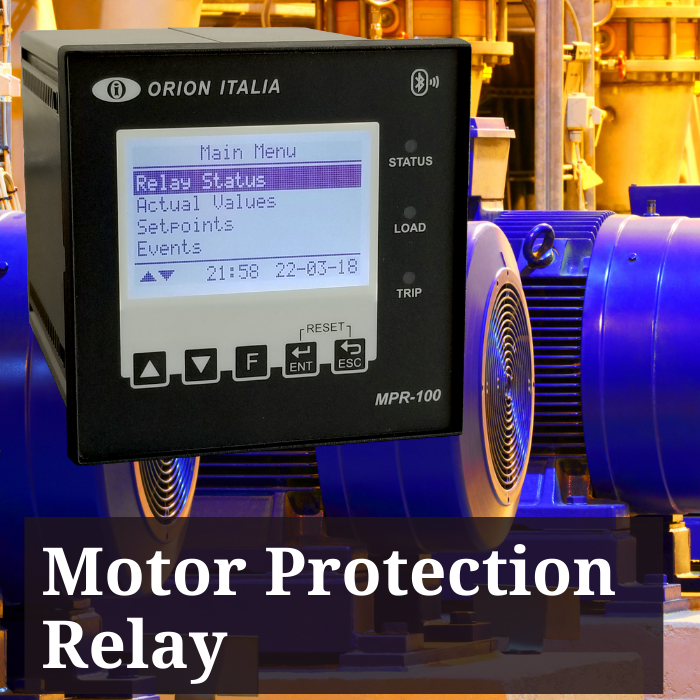Electric Motor protection
Protection of electric motors
It is carried out through devices that ensure the timely disconnection of electric motors from the network in the event of alterations to the normal work regime, in order to avoid deterioration of the motor insulation, windings and electrical connections
Orion Italia has hundreds of thousands of protection relay units installed around the world, click the link below to learn more about our digital device for motor protection:
Electric Motor Operation
During the operation of electric motors, various alterations to the normal regime can occur. The most frequent causes of abnormal motor speeds are overloads, short circuits, decrease or disappearance of voltage. Overload is called the increase in the current of the motor above the nominal magnitude. Overloads can be small and short-lived. These are not dangerous for the engine and should not be the object of attention as far as protection is concerned. But, if they are excessive and prolonged, they are dangerous for the motor windings, because the large amount of heat given off by the current can char the insulation and burn the windings. Short circuits in its windings are also dangerous for the motor. Protecting motors against overloads and short circuits is called overcurrent protection. The maximum protection is realized by means of fuses, current relays and thermal relays. The selection of the type of protection device depends on the power, the type and use of the motor, the starting conditions and the nature of the overload.
Click below for more information on:
- Pt100 temperature sensor for motor winding
- Complete solution (Pt100, Motor temperature protection relay)
- Ready industrial box with terminals and wiring for Pt100 sensors
Requirements for the protection of electric motors
In every motor branch circuit there must be some minimum requirements for the protection of low voltage motors:
- Sectioning. It is provided by a device that is capable of opening the circuit with visual indication of ON - OFF. The purpose is to guarantee the opening of the branch circuit safely, to protect users and operators.
- AutomaticProtection Short Circuit. It is an instantaneous action device (magnetic or electronic) capable of detecting and cutting any current greater than the starting current of the motor, which can be several times the nominal current, depending on the Code Letter of the motor. This can be a fuse, magnetic coil or electronic relay protection coupled to a current transformer.
- The Maneuvering Device. Usually electromagnetic contactors are used as starters or electronic soft start. It's not really a protection, although it can withstand starting currents. Although it is to control the starting and stopping of the motor, in fact it is the device that opens and closes the branch circuit of the motor both in normal operation and in overload.
- Overload Protection. This device is designed to detect overload currents composed above the nominal current; but lower than short-circuit currents. Although it also senses the higher currents, its actuation is delayed and it does not act fast enough to clear them. This must be done by the short-circuit protection. In this case, bimetallic relays, time-delay fuses and are usually used electronic relays.
Relays or multifunction electronic devices
Devices have even been developed that are capable of meeting all the requirements of the standard together. They are the so-called integral protectors or motor Savers. Relays or multifunction electronic devices are manufactured for the protection of motors. The most modern ones incorporate serial communication ports to digitally transmit all the data of the motor circuit where they are installed. The data is sent to a microprocessor or computer to produce the necessary alarm signals and corrective actions. With this type of relays the following fault conditions can be detected:
Maximum Temperature. Insulation is the most vulnerable part of motors. It is stated that the life of an engine is in direct relation to the life of its insulating system. If the maximum temperature that it can withstand is not exceeded, the motor could serve for many years.
INSULATION CLASS
Since heat is the main cause for a motor to burn out, it seems logical that the most effective protection is precisely some device that allows detecting an increase in temperature around the winding. Eventual overheating and even more permanent overheating decrease the life of an engine. Bimetallic thermal relays constitute the simplest and most well-known system of thermal protection by indirect control, that is, by heating the motor through its consumption.
Phase Balance. When the systems voltage that supply a motor are out of balance, then positive sequence and negative sequence magnetic fields are formed in the stator that determine opposite torques on the rotor. In this condition the machine loses efficiency and the lost energy is transformed into a greater quantity of heat. This eventuality could be foreseen by means of devices that prevent the motor from working when the phase voltages are outside the preset range.
Single-Phasing. An extreme condition of phase unbalance occurs when any of the phases is missing from the three-phase system. The motor is then connected in a single phase but is unable to generate the torque necessary to overcome the mechanical load or to start. Then, in the induction machine, the operating point is moved towards the overload zone and to the same breaking point, stopping the rotor and remaining in operation under the locked rotor condition; that as we know, staying there is the closest condition to a short circuit.
For this condition, a device could be used that allows sensing the presence of the three phases and interrupting the operation when one of them is missing.
Rotation of the shaft. If the motor is energized but the shaft does not rotate, obviously it will be taking the starting current (LRA) from the network, which as we know can be several times the nominal current. The installation of a device that can detect the movement of the axis, will be a convenient protection.
Rotation speed. A complementary case of the previous protection is the rotation speed condition. Whether the shaft does not rotate or at a speed below the rated full load speed, the operating point drifts into the overload zone and can dangerously move into the break zone and is suddenly blocked. Even turning at low speed, fan cooling becomes ineffective and the winding temperature will increase dramatically.
Vibrations. Mechanical vibrations translate into shaft loads that displace the motor's nominal operating point, with the consequent increase in temperature. A system that allows sensing vibrations and inhibits engine operation under these conditions would be the most recommended protection.
No. of starts and stops. Continuous starts and stops increase the accumulated heat in the winding. There are counting devices that can prevent the motor from starting when a predetermined number of starts has been equalized in a given period of time.
Moisture in insulation. One of the polluting factors in insulation is humidity. In effect, the accumulation of humidity facilitates the leakage currents through the insulating material, exposing the motor to a ground fault condition, between phases or to a short circuit as the case may be.
When an engine is idle, its insulation system accumulates moisture; so the insulation resistance could get very low values. In some cases it would be enough to maintain a slight DC current that feeds the winding during non-operating periods; This would keep the winding slightly warm, preventing the accumulation of moisture.
There are relays that allow the incorporation of a continuous monitoring system of the insulation resistance of the motor when it is de-energized.
Ground fault. Ground fault is the most frequent condition that occurs due to loss of insulation in motors. Vibration, joule effect, friction, contamination and heat are the proximate cause in almost all winding ground fault cases. A ground fault relay may be the most suitable solution.
Insulation faults. Insulation faults degenerate into short circuits between turns of the same phase, to ground, between phases and three-phase. The latter is the most bloody and destructive of all.
Maximum locked rotor time. When the motor is energized, the rotor starts from the stopped condition to the rotating condition. This process should take a relatively short time until the rotor reaches rated speed, around 90% to 95% of synchronous speed. A device can be used that measures boot time and shuts down the system in the event that the preset boot time is exceeded. This condition should also be cleared by short circuit protection; only that it is adjusted above the RLA value, leaving the motor unprotected in a certain range.
Rotor lock while running. This is a special condition: the rotor was rotating normally and stops quickly. A similar problem could be caused by a sudden mechanical overload. In this case, it would be necessary to detect the rotation of the rotor and disconnect the supply in the event of an untimely stop.
Idle running. Idle running is manifested by overspeed. This occurs due to a sudden or sudden loss of mechanical load. This condition is critical in series type DC motors, since without load, the motor crashes and can be destroyed.
On the other hand, an induction motor that rotates at a speed very close to that of synchronism, remains outside the nominal operating point, being less efficient and therefore, releases energy in the form of heat.
For both cases, it would be convenient to detect the rotation speed and indicate the overspeed condition or loss of load.
Inversion of the direction of rotation. The direction of rotation in three-phase motors is determined by the sequence of the phases and in single-phase motors by the direction of the current in the starting winding as opposed to the running one. Some motors and their loads may be designed for this condition of reversal of the direction of rotation; others don't.
The direction of rotation is also reversed when the load exerts a drag torque much greater than the reactive torque of the motor. In this case, the rotor is dragged until it rotates backwards, which would be an extreme condition with respect to the current that the motor draws from the network.
Selection and adjustment of protection devices
The following recommendations are intended to guide users in the selection of the most appropriate protection devices for each case. The settings are the maximum settings allowed by the standards. It is clear that each case is a particular problem that must be solved with a more detailed study that must be carried out by a professional in the field.
Fuses
Application: Short Circuit Protection. Highly recommended in transformer protection and also as backup protections for other protection devices. In motors, a double element fuse can be used to provide a range of protection that includes the overload range. Selection: Based on the nominal current and also taking into account the Interrupting Capacity. Fit: They have no fit. The maximum value allowed by the standards is 300% of the nominal current. There are different types depending on their use and the expected operating time, and they can be slow, fast and ultra-fast among others.
Bimetallic Relays
Application: Widely used in overload protection (also named overcurrent) in low voltage motors. Selection: They are selected according to the nominal current of the motor at the working voltage. Adjustment: They can be adjusted between 80% and 125% of the rated motor current. The maximum setting value is 125% of the rated motor current. The recommendation is to adjust it to a lower value, allowing it to start normally. Interruption Capacity. It is the maximum Short Circuit current that the device can safely interrupt, without exploding.
Magnetic Switches
Application: Recommended for short circuit protection, especially in motors. Selection: Based on the value of the short-circuit current and the insulation damage curve. It is normally selected based on the maximum expected value of the starting current. Fit: Not all have fit. In case of having it, the recommendation is to adjust it to the minimum possible, as long as the starting of the engine is allowed. The maximum setting allowed by the standards is 700% of the rated current, depending on the Code Letter (*) and the Service Factor (**) of the motor.
Thermo-magnetic switches.
Application: Widely used in low voltage protections. They are useful in protecting general lighting loads, ovens, electrical outlets, etc. They are not as efficient in protecting motors because of the range of starting and overload currents. Selection: In consideration of the nominal current of the load and the short-circuit interrupting capacity. Fit: Not all have fit. Some of higher price, allow instantaneous tripping adjustments for protection in the range of short-circuit currents; more properly, in the range of starting currents. More modern and sophisticated versions, allow adjustments of both ranges. The maximum value of the short-circuit trip setting allowed by the standards is 700% of the rated current and the overload setting is 250% of the rated current.










